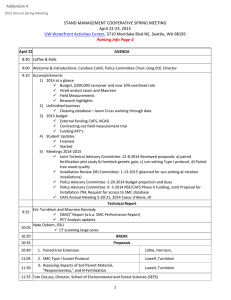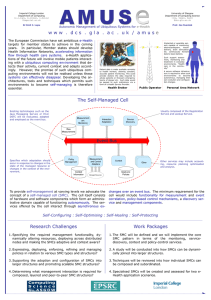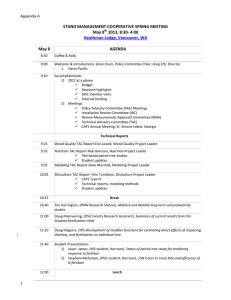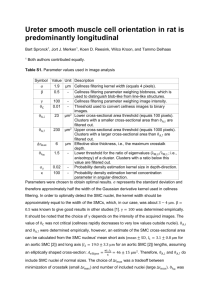SMC Quar ter y News SMC Quarter
advertisement
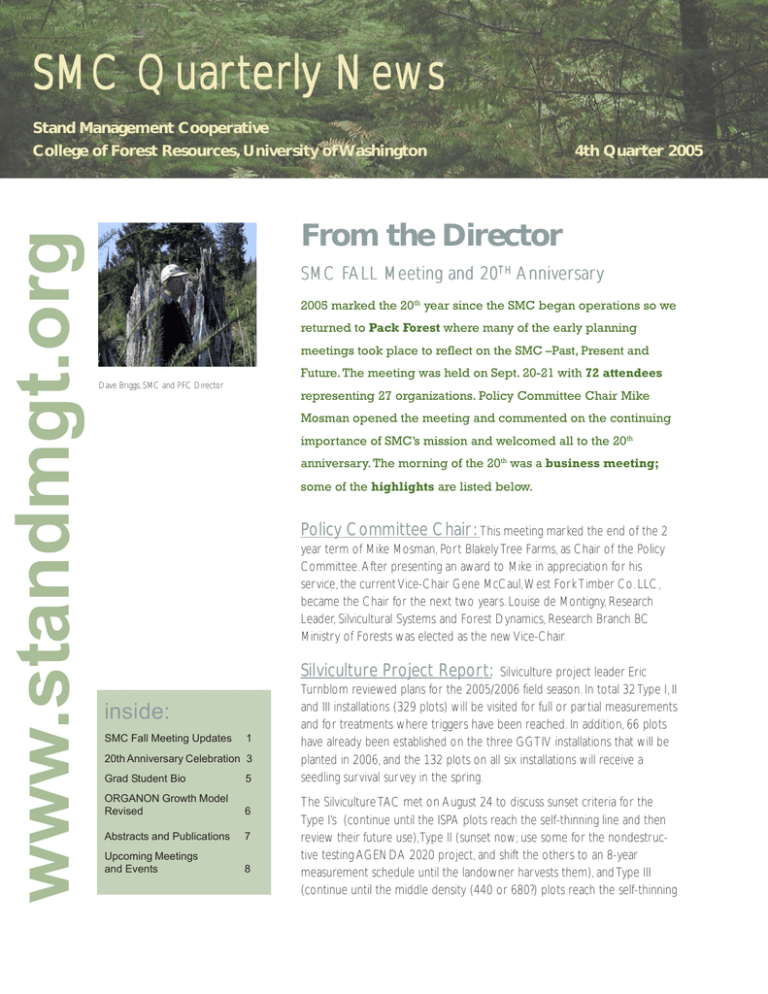
SMC Quar ter ly News www.standmgt.org Stand Management Cooperative College of Forest Resources, University of Washington 4th Quarter 2005 From the Director SMC FFALL ALL Meeting and 20TH Anniv er sar Anniver ersar saryy 2005 marked the 20th year since the SMC began operations so we returned to Pack Forest where many of the early planning meetings took place to reflect on the SMC –Past, Present and Future. The meeting was held on Sept. 20-21 with 72 attendees Dave Briggs, SMC and PFC Director representing 27 organizations. Policy Committee Chair Mike Mosman opened the meeting and commented on the continuing importance of SMC’s mission and welcomed all to the 20th anniversary. The morning of the 20th was a business meeting; some of the highlights are listed below. Policy Committee Chair: This meeting marked the end of the 2 year term of Mike Mosman, Port Blakely Tree Farms, as Chair of the Policy Committee. After presenting an award to Mike in appreciation for his service, the current Vice-Chair Gene McCaul, West Fork Timber Co. LLC, became the Chair for the next two years. Louise de Montigny, Research Leader, Silvicultural Systems and Forest Dynamics, Research Branch BC Ministry of Forests was elected as the new Vice-Chair. Silviculture Project Report: inside: SMC Fall Meeting Updates 1 20th Anniversary Celebration 3 Grad Student Bio 5 ORGANON Growth Model Revised 6 Abstracts and Publications 7 Upcoming Meetings and Events 8 Silviculture project leader Eric Turnblom reviewed plans for the 2005/2006 field season. In total 32 Type I, II and III installations (329 plots) will be visited for full or partial measurements and for treatments where triggers have been reached. In addition, 66 plots have already been established on the three GGTIV installations that will be planted in 2006, and the 132 plots on all six installations will receive a seedling survival survey in the spring. The Silviculture TAC met on August 24 to discuss sunset criteria for the Type I’s (continue until the ISPA plots reach the self-thinning line and then review their future use), Type II (sunset now; use some for the nondestructive testing AGENDA 2020 project, and shift the others to an 8-year measurement schedule until the landowner harvests them), and Type III (continue until the middle density (440 or 680?) plots reach the self-thinning line and then review their future use). The group also discussed the need for future GGTIV’s in other breeding zones/species recognizing that no new genetic gain trials are being planned. This means that the number of plots reflecting the Type IV component would only be 9, hence the installations could be much smaller in size. It was decided that there should be more discussion of this and other objectives/designs at a future TAC meeting. The group also discussed the issue of future nutrition/fertilization trials and decided that a Nutrition TAC meeting was needed to clearly define the questions that need to be addressed. Once those are identified we can then investigate the appropriate experiments that would be needed. The TAC also discussed procedures to use in the GGTIV’s to assess planting site conditions; schedules, procedures, and criteria to assess, monitor, and treat competing vegetation; and placement of rain, temperature, and other instrumentation on these installations. Draft procedures will be circulated and discussed at the next TAC meeting. Modeling Project Report: Modeling project leader Greg Johnson summarized progress on the young stand model, with Martin Richie and Dave Marshall as Co-PI’s, funded by AGENDA 2020 funds from the PNW and PSW stations with a 20% match from the SMC. The Modeling TAC held a meeting in June to discuss this project which will calibrate the CONIFERS young stand growth model to planted Douglas-fir in Oregon and Washington. It is designed to project planted trees from planting to a time when the trees would be passed to one of the older stand models. The new version will be based on SMC Type III installations and some data from RVMM. Nick Vaughn, a UW graduate student working with Eric Turnblom, has just been hired on this project. Dave Marshall reported on the SMC ORGANON update. This “Phase II” project with Dave Hann, Dave Marshall and Mark Hanus as Co-PI’s, funded by the SMC at the Fall 2004 meeting, incorporates data obtained from the SMC installations gathered over the past 20 years. The re-estimation of equations has been completed. The “Phase 2” version was extensively reviewed and discussed at the Modeling TAC meeting in June, and tested since then. It is now complete and ready for release. There are plans for publication of the revised equations as an OSU report as well as one or more journal articles. Nutrition Project Report: Nutrition project leader Rob Harrison briefly reviewed five papers based on Fall River and SMC studies that have been submitted to journals. He then summarized work to date on the carryover study of harvested RFNRP plots. Now that these plots have been monitored for several years, seedlings on the plots where the previous stand was fertilized are significantly taller and larger in diameter than counterparts in plots that had not been fertilized. Wood Quality Project Report: Wood Quality project leader Eini Lowell reviewed a Wood Quality TAC meeting on September 15. Based on the recommendation from the Silviculture TAC to sunset Type II installations and use them for wood quality research, the group discussed a proposal by David Briggs to use a set of these for the Agenda 2020 study that is examining the use of nondestructive testing for evaluating wood quality of standing trees and logs. This study is using new acoustic wave tools for standing trees and logs to evaluate wood stiffness and the proposed use of the Type II’s would be to 2 use them as the basis for establishing tree to log to product (lumber and veneer) relationships. A tentative sampling procedure was worked out for further review. The TAC also reviewed the notes from the wood quality workshop held October 2003 by Jamie Barbour’s Focused Science Delivery Program as a start to determine how to move forward on the recommendations from that meeting in concert with the input received during the SMC Strategic Planning meeting held January 2005. A proposal to study the effect of bear damage on lumber quality was also discussed. DNR Capitol Forest (Olympia, WA) has a long history of bear damage and some SMC installations also have bear damage. PNW ESP Team has agreed to do a product recovery study on a sample of trees and Dave Marshall (PNW Research Station, Olympia) has expressed an interest in looking at how bear damage affects tree growth. GGT/Type IV Installations: Seedling survival on the installations planted in 2005 is excellent. A survey in early September found that survival exceeded 96% on all plots except for one which had 90% survival. The TAC will review this to determine the need to replace trees on any of the plots – we do have seedlings from each gain level stockpiled for that purpose if needed. The three installations for the 2006 planting have been selected and plots have been established. Each of the six installations was contributed by a different landowner (Green Diamond Resources, Port Blakely Tree Farms, Quinault DNR, Rayonier Forest Resources, Washington DNR, and Weyerhaeuser Company) and are well distributed across the Grays Harbor breeding zone. The seedlings for the 2006 planting are growing at the Sylvan Vale nursery; the number of seedlings in each gain level exceeds needs and a late August survey found that 99% met height requirements and 99% met caliper requirements. Matt McLaughlin, RTI Internet Information Specialist, video taping the SMC’s 20th Anniversary meeting for a streaming video that is available on the SMC web site. Technical Session: The Technical Session began on the afternoon of April 20 and continued through the morning of April 21. See the agenda for titles of speakers and titles of presentations. Many can be downloaded from the SMC website (www.standmgt.org). 20TH ANNIVERSAR Y CELEBRA TION ANNIVERSARY CELEBRATION The afternoon program focused on the 20th Anniversary of the SMC with the theme “The SMC – Past Present and Future”. Bob Curtis led off with an account of why and how the concept of the SMC began, culminating with the Prospectus in 1984 that led to the SMC’s formation and start-up in 2005. Dave Hyink followed highlighting many of the accomplishments that have occurred during the past 20 years. For example, during this time, the SMC cumulative budget has reached $14.5 million of which nearly 2/3 is from dues contributed by members and the balance split by contributions by institutions and external grants which have picked up rapidly in recent years. SMC researchers have also 87 articles in peer reviewed scientific publications, 133 other publications, has developed 6 software systems, and graduated 8 PhD and 21 Masters students. Dave’s presentation was followed by short summaries of some of the types of past and current studies of SMC researchers. Greg Johnson then spoke of the current directions of research and the increasing trend toward collaboration among cooperatives that is being driven by research questions that require a more interdisciplinary approach. This was followed by short summaries of examples of collaborative efforts such as the Long-Term Site Productivity studies, and collaborations between the SMC and Northwest Tree Improvement Cooperative and with the Pacific Northwest Tree Im- 3 Jack Zaccardo, local logging historian from Forks, Washington presenting a slide show on early logging at the SMC meeting. provement Research Cooperative. Peter Farnum, Vice President of Weyerhaeuser, discussed “How Information Needs and Implications for Research will Provide the Future Directions of Forest Management” and Bruce Bare, Dean of the College of Forest Resources at the University of Washington discussed how the College is changing to meet the challenges of today and the future. All of the presentations were captured on streaming video and will be on the SMC website or available on CD by request. The evening slide show on early logging by Jack Zaccardo was very entertaining and interesting. Field Tour: September 21st About 30 attended the field tours of King Creek I (Type III) and Longbell Road (Type I) to see the remarkable changes taking place as they respond to the treatment regimes. SMC field trip at the King Creek site TECH TRANSFER Over the summer, the database staff (John Haukaas and Randy Collier), responded to four requests for one-on-one briefing sessions on the features of the SMC database. These oneon-one sessions allow the information presented to be tailored to the specific needs and interests of the organization. The first session was given to three people at the Olympia office of the Washington State DNR on July 19. The next session was delivered to Chris Lipton of Longview Fibre on July 20th. Four staff members of the Quinault Nation Department of Natural Resources attended a session on the 9th of August. The last session of the summer was given to two staff members of Lone Rock Timber. Two more briefing sessions have been requested for October / November. In August, we held a demonstration of the tree and log acoustic testing tools for the Washington DNR at a timber sale where we could test standing trees and the logs from them. In addition, we held a field tour with 15 personnel from the Oregon Department of Forestry in Astoria, Oregon, on August 31. After an overview of the SMC programs, we visited Gnat Creek, one of the Type I Installations. NEW GRANTS & CONTRA CTS CONTRACTS This year we have received $11,000 from the Red Alder Modeling Group for work on developing the database that will support a future red alder modeling effort and $11,000 from the USDA PNW Research Station that supported our work on the streaming video proceedings of the Alder Symposium in March. Rob Harrison received an additional $40,000 from NCASI to support work on the Fall River study. We have other proposals in review. 4 MARK YOUR CALENDARS FOR THE 2006 SPRING AND FALL POLICY COMMITTEE MEETINGS ing Meeting will be held on April 25-27 at McMenamin’s in conjunction with the The Spr Spring AGENDA 2020 project reviews. Since a number of the AGENDA 2020 projects have links to the SMC and many of the researchers and reviewers would attend both meetings if they were held separately, it makes sense to do both in a single meeting framework. Presently, the schedule is to hold the Agenda 2020 reports on the 25th and the morning of the 26th, with the SMC Policy Committee meeting on the afternoon of the 26th and the morning of the 27th. Additional details will be sent in the future. The Fall Meeting will be held on September 11-13, 2006 at the Loon Lake Camp on the University of British Columbia Research Forest at Haney. Most will likely wish to arrive the evening of the 11th. Accommodations there have been booked and we will be sending more details in the future. STUDENT BIO NICK VAUGHN, UNIVERSITY OF WASHINGTON, COLLEGE OF FOREST RESOURCES M.S. CANDIDATE IN QUANTITATIVE RESOURCE MANAGEMENT, CFR While I don’t have a specific goal for my life in mind yet, I have known that I enjoy the mathematical side of forestry for quite a while. This led me to go back to school at the University of Washington for a degree in forest biometrics. As I am writing this, I am in my third week of my first quarter of classes. I am working under the advice of Dr. Eric Turnblom. My undergraduate work was at Humboldt State University in Arcata, California. There, in the finest region of California, I received my Bachelor’s degree in Forestry in 2001. Loon Lake Camp is located approximately 60 km from downtown Vancouver, on the shores of Loon Lake. This beautiful lakeside setting is found within the UBC Malcolm Knapp Research Forest, a 5000 hectare Forest dedicated to research and education in the field of Forestry. After graduating, I got a job with the Forest Service at Pacific Southwest Research Station in Redding, CA. At PSW I worked as a database manager and part time analyst for Martin Ritchie. After three years of database management, I decided that I preferred the analysis part of my job. However, Nick Vaughn if I was going to do more analysis, I needed to learn more about number crunching. This made my plans to go back to school concrete. Fortunately, around the same time I was seriously considering going back to school, the SMC was deciding that it wanted a Pacific Northwest rendition of the young stand growth equations that Martin created for the CONIFERS simulator. So, it worked out that my Master’s project is going to be fitting these equations with the SMC type III data. I’m excited to be working with the members of the SMC, and that my project will be of benefit (hopefully) to them. The more I think about my next two years (at least), the more I realize how little free time I will have. However, when I used to have free time, I enjoyed many hobbies including bicycling, running, home-repair, woodworking, home brewing, and backpacking to name a few. I am married to a wonderful woman (who is working hard on a Masters in Social Work at the same time). We are acclimating to the area after fighting with the Seattle traffic for a while. We are both beginning to enjoy living in the Pacific Northwest and are glad we made the decision to come up here. 5 The ORGANON Gro wth Model Revised Growth David Marshall, Research Forester, USDA, PNW Research Station, Olympia Laboratory David Hann, Professor, Oregon State University Introduction Figure 1 – Differences between the actual 5-year diameter growth and predictions using the diameter growth equation from SMCORGANON Edition 7.0 for Douglas-fir from SMC installations. Figure 2 — Differences between the actual 5year diameter growth and predictions using the new diameter growth equation from SMCORGANON Edition 8.0 for Douglas-fir from SMC installations. In the early 1990s, the Stand Management Cooperative decided to build a variant of the ORGANON growth model. The modeling effort utilized data from 3,345 permanent plots in Oregon, Washington and British Columbia. However, the SMC installations were still being established, were only beginning to be remeasured, and, as a consequence, could not provide much data for this modeling project. The resulting model reflected the best data sets available at the time, which included little actual plantation data and poor samples of tree heights and crown measurements. The initial modeling project anticipated this by providing a framework for future modeling work and the 1991 SMC Modeling Project 5-year plan outlined a Phase II of the modeling work to make use of SMC data as they become available. Since the completion of original SMC-ORGANON model there has been additional plots established (Type I and III installations), plot remeasurements of growth, Flewelling’s site curves were developed for young stands (in 2001), and corrections/additions have been made to the database (most notably tree and installation ages). In addition, data from the SMC plots in young Douglas-fir plantations were showing high diameter and height growth rates that appeared to be underpredicted by the model. The time was right for Phase II and, at the Fall 2004 SMC meeting, the cooperative approved a project to re-analyze the diameter growth and height growth equations for untreated Douglas-fir in the SMC variant of the ORGANON growth model. The project was carried out by David Hann (Oregon State University), David Marshall (PNW Research Station) and Mark Hanus (FORSight Resources) and has been completed ahead of schedule. The objective of the project was to use the dataset for untreated plots from the previous modeling project and add data for untreated Douglas-fir plots from the current SMC database. The project began by editing the SMC data, computing plot ages and site index and creating modeling datasets. Next the existing models were tested against the SMC data. ORGANON is an individual tree model and main component models for Douglas-fir are: • Height-diameter (for filling in missing heights) • Height-to-crown-base (for filling in missing heights and computing change in crown ratio) • Diameter growth Figure 3 — Differences between the actual 5-year heght growth and predictions using the new height growth equation from SMC-ORGANON Edition 8.0 for Douglas-fir from SMC installations. • Height growth • Mortality The evaluation of these models showed that the height-diameter and height-tocrown-base models adequately fit the SMC data for the Type I, II and III installations. 6 As expected the original diameter growth equation showed large underpredictions in very young stands (figure 1). The two surprises of this analysis was that the height growth model did well in predicting growth in these young stands and the mortality models tended to underpredict mortality in the young stands. It was decided to refit the diameter growth (figure 2), height growth (figure 3) and mortality models. Additional data sets from stands in southwest Oregon (used to develop SWO-ORGANON), northwest Oregon (used to develop NWO-ORGANON) and western Washington (the latter provided by Doug Maguire, OSU) were added to the diameter growth analyses to provide more robust estimates in larger trees. The resulting diameter and height growth models were validated using an independent data set of young stands from the Oregon coast, also provided by Doug Maguire. The new equations were incorporated into ORGANON (Edition 8), and were tested by running all the SMC plots used in modeling. The results were compared to output from the original SMC-ORGANON (Edition 7). The new model predicts similar age of maximum mean annual increment (an increase that averages 2.6 years later), and it predicts an average of about 21% lower in MAI of total stem cubic foot volume per acre (average of 219 ft3/ac/year). The dynamics of the new version of the model predicts faster early growth rates that result in earlier competition and mortality. Another interesting dynamic of the model is that it appears to follow a self-constrained self-thinning trajectory that approaches an average maximum SDI of about 480. This is in contrast to version 7 in which a maximum SDI of 520 would have to be imposed to control stand development. The results of this project are exciting and are a major improvement to the ORGANON model. The model now produces tree growth estimates for young plantations and very reasonable yield estimates at rotation. The model can also produce wood quality information for individual trees that can be analyzed by Roger Fight’s TreeVal program. The new version of SMC-ORGANON can be run as a console version as in the past or as a DLL for added flexibility for incorporating it into existing planning systems or databases. The new version 8 of the SMC-ORGANON model and manuals will be available soon for downloading from the ORGANON web site at: http:// www.cof.orst.edu/cof/fr/research/organon/ Abstr acts and Abstracts Pub lications Publications Constance A. Harrington and Schoenholtz, Stephen, H. Productivity of Western forests: A forest products focus. Gen. Tech. Rep. PNW-GTR-642. Portland, OR: U.S. Department of Agriculture, Forest Service, Pacific Northwest Research Station. 176 p. Abstract In August 20-23, 2004, a conference was held in Kamilche, WA, with the title “Productivity of Western Forests: A Forest Products Focus.” The meeting brought together researchers and practitioners interested in discussing the economic and biological factors influencing wood production and value. One of the underlying assumptions of the meeting organizers was that management activities would be practiced within a framework of sustaining or improving site productivity; thus, several papers deal with methods to protect or improve productivity or discuss new studies designed to test the effects of various practices. The proceedings include 11 papers based on oral presentations at the conference, 3 papers based on posters and 2 papers describing the Fall River and Matlock Long-Term Site Productivity study areas visited on the field tours. The papers cover subjects on forest harvesting activities, stand establishment, silviculture, site productivity, remote sensing, and wood product technologies. Robert Curtis and Marshall, David. Permanent-plot procedures for silvicultural and yield research. Gen. Tech. Rep. PNW-GTR-634. Portland, OR: U.S. Department of Agriculture, Forest Service, Pacific Northwest Research Station. 86 p. Abstract This paper reviews purposes and procedures for establishing and maintaining permanent plots for silvicultural and yield research, sampling and plot design, common errors, and procedures for measuring and recording data. It is a revision and update of a 1983 publication. Although some details are specific to coastal Pacific Northwest conditions, most of the material is widely applicable. 7 Upcoming Meetings and Ev ents Events November 4, 2005 noon to 6 PM-UW College of Forest Resources Alumni Association (CFRAA) Annual Meeting, social hour and banquet. University of Washington Center for Urban Horticulture, Seattle, WA.,This year the SMC and the PFC will be showcased. For more information contact moshea@u.washington.edu. November 8-9, 2005- The 9th Annual PNW Integrated Vegetation Management Conference: The Role of Integrated Vegetation Management in Restoration Ecology. Holiday Inn Portland Airport ,Portland, Oregon. For more information visit: www.westernforestry.org/intvegmgmt/intvegmgmt.htm. November 9-10, 2005-Volcanic Ash-cap Forest Soils of the Inland Northwest Properties and Implications for Management and Restoration. Coeur d’ Alene Resort, Coeur d’ Alene, Idaho. For more information visit: http://www.westernforestry.org/ashsoil/ ashsoil.htm. November 30-December 1, 2005-Sustainable Wood Production Initiative: Timber Supply, Land Use and Sustainable Forestry Options in the PNW. Hilton Hotel, Vancouver, WA. For more information visit: http://www.westernforestry.org/sustainwood/ sustainwood.htm April 25-27, 2006-AGENDA 2020 PI Reports and SMC Policy Committee Meeting. McMenamin’s, Troutdale, OR. September 11-13, 2006-SMC Fall Policy Committee Meeting. Loon Lake Camp, University of British Columbia Research Forest, Hanely, BC. College of Forest Resources University of Washington Box 352100 Seattle, WA 98195
